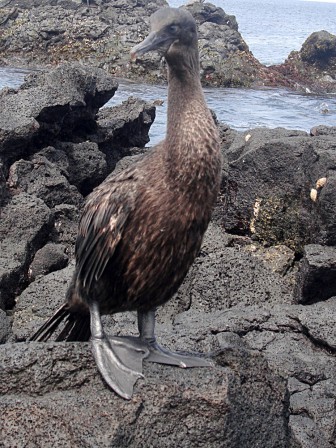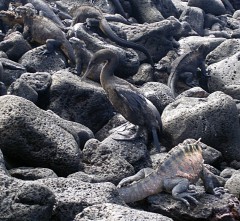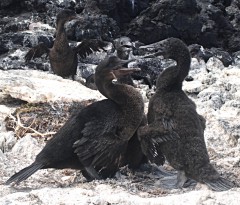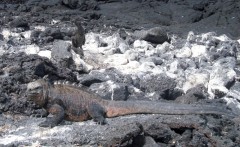Cormorans des Galapagos / Galapagos' Cormorants
Par Luc Fougeirol le mercredi 6 mars 2013, 11:55 - Les Galapagos, havre de paix - Lien permanent

 Sur les îles Galapagos, la nature offre un spectacle permanent et unique. Elles sont nombreuses les espèces, pour la plupart endémiques, et principalement reptiles, à avoir retenu mon attention.
Sur les îles Galapagos, la nature offre un spectacle permanent et unique. Elles sont nombreuses les espèces, pour la plupart endémiques, et principalement reptiles, à avoir retenu mon attention.
 Mes visites successives m'ont permis de les observer. Après de nombreux voyages avec Michel Gunther, ornithologue et photographe, je regarde les oiseaux avec beaucoup plus d'intérêt. Parmi eux, le Cormoran aptère (Phalocrocorax harrisi), dont on trouve des colonies sur les îles de Fernandina et d'Isabela, m'a vraiment interpellé.
Mes visites successives m'ont permis de les observer. Après de nombreux voyages avec Michel Gunther, ornithologue et photographe, je regarde les oiseaux avec beaucoup plus d'intérêt. Parmi eux, le Cormoran aptère (Phalocrocorax harrisi), dont on trouve des colonies sur les îles de Fernandina et d'Isabela, m'a vraiment interpellé. 
Son regard turquoise est captivant, sa démarche maladroite fait penser que ses palmes sont trop grandes pour lui. Elles lui sont évidemment très utiles pour nager. C'est dans l'océan qu'il va chercher poissons, pieuvres et calamars. Son bec et son cou très longs lui permettent cependant de débusquer, au cœur des rochers, sa nourriture.
Ses ailes, atrophiées, lui donnent aussi un air atypique, surtout quand il les étale au soleil, comme le font les espèces de cormoran présentes en Europe.
Il est très amusant de l'observer ramenant des algues dans son bec pour construire un nid sur la lave, où sa couleur sombre le rend difficilement visible.
Cet oiseau m'a interpellé d'autant plus qu'il cohabite avec de nombreux iguanes marins.
 Galapagos' Cormorants
Galapagos' Cormorants
On Galapagos Islands, nature provides a permanent and unique show.
 Many species, mostly endemic and mainly reptiles, have caught my attention. My successive visits allowed me to observe them. After numerous trips with Michel Gunther, ornithologist and photographer, I look at the birds with more interest. Among them, the Flightless Cormorant (Phalocrocorax harrisi) attract my attention. We found colonies on the islands of Fernandina and Isabela.
Many species, mostly endemic and mainly reptiles, have caught my attention. My successive visits allowed me to observe them. After numerous trips with Michel Gunther, ornithologist and photographer, I look at the birds with more interest. Among them, the Flightless Cormorant (Phalocrocorax harrisi) attract my attention. We found colonies on the islands of Fernandina and Isabela.
It's turquoise look is fascinating, its clumsy gait suggests that its palms are too big for him. They are obviously very useful for him to swim. In the ocean cormorants fetches fishes, octopuses and squids. Its very longs beak and neck, allow it to however to chase away, in the heart of the rocks, its food.
Its wings atrophied, also give this bird an air atypical, especially when it spreads them in the sun, as do the cormorant species present in Europe. It is very funny to observe it returning seaweeds in its beak for building a nest on the lava, where its dark color makes it uneasily visible.
It is very funny to observe it returning seaweeds in its beak for building a nest on the lava, where its dark color makes it uneasily visible.
This bird caught my attention especially because it lives with numerous marine iguanas.